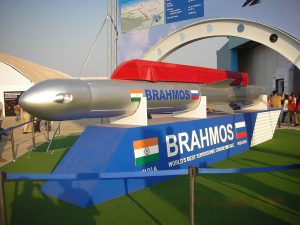According to reports from Indian media, in less than a month, the Indian military has tested extended-range (ER) BrahMos missiles from various platforms, including a ground-based launcher, a naval vessel, and a fighter aircraft. The recent tests suggest efforts to enhance the reliability, range, and precision of the BrahMos missile. These are significant developments. Last year an unauthorized missile landed in Pakistan, which raised serious concerns about the missile’s functioning and Indian command and control systems.
The tests are being conducted as a preliminary phase before the official induction of improved and upgraded BrahMos missiles into the Indian military. India’s efforts to upgrade the cruise missile indicate a strong commitment to enhancing its counter-force capabilities, which has adverse implications for strategic stability in the South Asian region.
The BrahMos is a nuclear-capable supersonic cruise missile designed and built collaboratively between India and Russia. Capable of traveling at speeds of up to Mach 3, it is one of the world’s fastest cruise missiles. The BrahMo possesses the capacity to carry a warhead weighing 300 kilograms, encompassing both conventional and nuclear payloads. The missile is the sole system inside the Indian arsenal that possesses the capability to be deployed from several platforms including air, sea, and land.
In addition, the cruise missile exhibits a range of trajectories, such as high, high-low, low, and surface-skim, in contrast to ballistic missiles, which are propelled for only half of their journey and follow a pre-defined parabolic trajectory. A BrahMos missile’s trajectory cannot be predicted so easily, which makes it difficult to counter missile defenses.
The recent launches marked the first time that all three ER missiles were tested one after the other in rapid succession. The testing commenced with the firing of an extended-range surface-to-surface land-attack version of the BrahMos from a ground-based launcher on October 10. The range was increased between 450-500 kilometers, from the initial range of 290 kilometers, according to Janes. The new missile was an improved version of the original missile in other ways as well. Besides increasing in range, its accuracy was improved by introducing an active radar seeker.
Indian Army sources revealed to the press that this exercise was part of induction trials. This demonstrates that the new system would be inducted soon and become an operational part of the Indian Army.
Following the ground test, the ER air-launched version of the BrahMos was tested on October 18, from an Indian Air Force Su-30 MKI fighter jet, the only current platform in the IAF arsenal with the capability to launch the BrahMos. The missile tested “was the longer version” of the supersonic BrahMos air-launched system, according to Indian media.
The ER missile has a range between 400-500 kilometers, with the ability to strike targets both at sea and on land. The new capability would allow the IAF to strike targets from standoff ranges and from outside the perimeters of enemy air defenses.
Last came the firing of an ER missile by the Indian Navy from a vessel in the Bay of Bengal on November 1. It was launched from a Rajput-class destroyer, the first in the Indian Navy to integrate with the BrahMos system.
These are several notable takeaways. For the first time in history, the extended-range missiles were tested from across all platforms. Tests are part of the final trials to make sure that the design, technical parameters, and performance of the different parts of the missile system are properly functioning. Moreover, the multiple tests will help ensure there are no future accidental and unauthorized launches of the missile system. Finally, the timing, synergy, and post-launch statements indicate that the ER missiles are about to enter into service soon.
The enhanced range BrahMos missiles will complicate the India-Pakistan deterrence equation. India already had the temptation to launch a counter-force strike against Pakistan. It is continuously in pursuit of acquiring precision strike systems to effectively execute a counter-force strike. The BrahMos ER is a continuation of this and it will certainly fulfill its existing policy objectives.
Now India will have a strategic capability to strike targets deep inside Pakistan’s territory with a standoff precision-strike weapon that is extremely difficult to intercept because of its maneuverability and high speed. This will adversely affect the current nuclear deterrence dynamics as the new range will bring distant targets within range of the BrahMos, as well as enhance Indian precision strike capabilities.
One might ask: Why does this extended-range BrahMos alter the balance of deterrence between both states, as Pakistan’s entire territory is already within range of Indian ballistic missiles? The answer lies in the precision, speed, diversity, and maneuverability of the BrahMos, which makes it different from the rest of the systems currently in service. First, as noted, ballistic missiles follow a pre-defined path, which makes them less useful for targeting mobile ground launchers. Second, they lack precision. The BrahMos’ strengths in these areas makes it a perfect counter-force weapon.
Also, it is the only weapon system that can be launched from either a transport erect launcher, naval ship, or fighter jet. Thus, these characteristics make it a first weapon of choice for Indian decision-makers.
The ER BrahMos missile will increase the potential risks of a first strike by India during any future crisis in South Asia, which will undermine the strategic stability in South Asia.

































